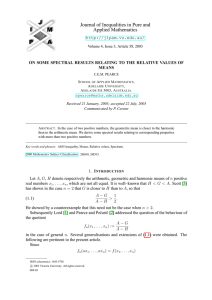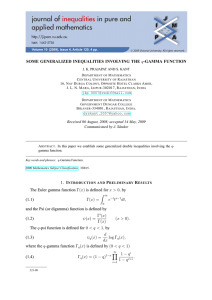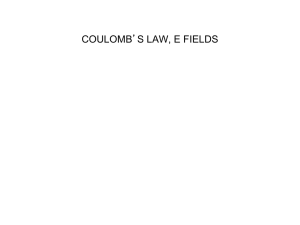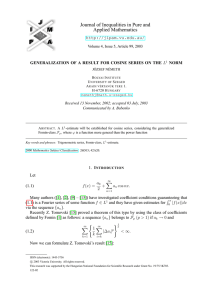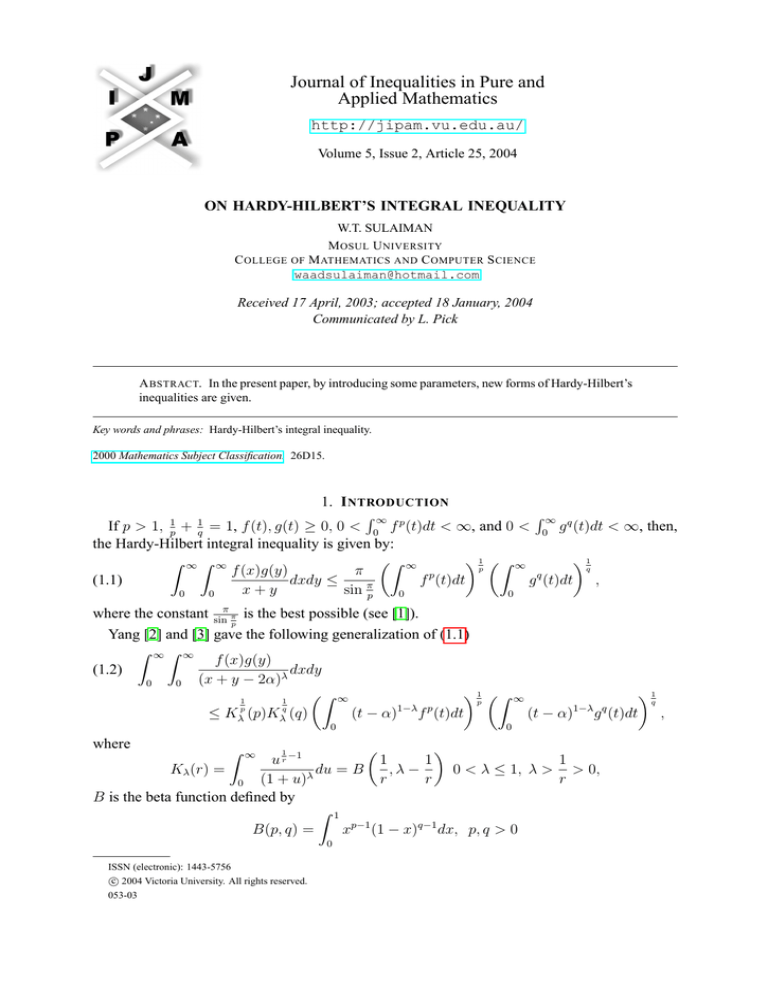
Journal of Inequalities in Pure and
Applied Mathematics
http://jipam.vu.edu.au/
Volume 5, Issue 2, Article 25, 2004
ON HARDY-HILBERT’S INTEGRAL INEQUALITY
W.T. SULAIMAN
M OSUL U NIVERSITY
C OLLEGE OF M ATHEMATICS AND C OMPUTER S CIENCE
waadsulaiman@hotmail.com
Received 17 April, 2003; accepted 18 January, 2004
Communicated by L. Pick
A BSTRACT. In the present paper, by introducing some parameters, new forms of Hardy-Hilbert’s
inequalities are given.
Key words and phrases: Hardy-Hilbert’s integral inequality.
2000 Mathematics Subject Classification. 26D15.
1. I NTRODUCTION
R∞
R∞
If p > 1, p1 + 1q = 1, f (t), g(t) ≥ 0, 0 < 0 f p (t)dt < ∞, and 0 < 0 g q (t)dt < ∞, then,
the Hardy-Hilbert integral inequality is given by:
Z ∞
p1 Z ∞
1q
Z ∞Z ∞
f (x)g(y)
π
p
q
(1.1)
dxdy ≤
f (t)dt
g (t)dt ,
x+y
sin πp
0
0
0
0
where the constant sinπ π is the best possible (see [1]).
p
Yang [2] and [3] gave the following generalization of (1.1)
Z ∞Z ∞
f (x)g(y)
(1.2)
dxdy
(x + y − 2α)λ
0
0
Z ∞
p1 Z
1
1
p
q
1−λ p
(t − α) f (t)dt
≤ Kλ (p)Kλ (q)
0
where
∞
1q
g (t)dt ,
1−λ q
(t − α)
0
1
u r −1
1
1
1
Kλ (r) =
du = B
,λ −
0 < λ ≤ 1, λ > > 0,
λ
(1 + u)
r
r
r
0
B is the beta function defined by
Z 1
B(p, q) =
xp−1 (1 − x)q−1 dx, p, q > 0
Z
∞
0
ISSN (electronic): 1443-5756
c 2004 Victoria University. All rights reserved.
053-03
2
W.T. S ULAIMAN
and, for 0 < T < ∞,
Z
T
T
Z
(1.3)
0
0
f (x)g(y)
dxdy
(x + y)λ
! 12
Z T"
λ2 #
1 t
λ λ
t1−λ f 2 (t)dt
≤β
,
1−
2 2
2 T
α
! 12
λ2 #
Z T"
1 t
t1−λ g 2 (t)dt
.
×
1−
2 T
α
In the present paper, by introducing some parameters, new forms of Hardy-Hilbert’s inequalities
are given.
2. N EW R ESULTS
We state and prove the following:
Lemma 2.1. Let λ > 0, p, q, r > 1,
and assume that
1
p
+
Z
1
q
+
1
r
= 1, f (t), g(t), h(t) ≥ 0, λi (t) ≥ 0, i = p, q, r,
b
λpp (t)f p (t)dt < ∞,
0<
a
Z
d
λqq (t)g q (t)dt < ∞
0<
c
and
Z
0<
d
λrr (t)hr (t)dt < ∞.
c
Then the two following inequalities are equivalent
Z bZ
d
Z
k
(2.1)
a
c
e
f (x)g(y)h(z)
dxdydz
hλ (x, y, z)
Z b
p1 Z
p
p
≤K
λp (t)f (t)dt
d
1q Z
c
a
r1
k
λqq (t)g q (t)dt
λrr (t)hr (t)dt
,
e
where K = K(λ, p, q, r) is a constant, and
Z
b
qr
q+r
Z
d
Z
λp (x)
(2.2)
a
c
e
k
qr
q+r
g(y)h(z)
dydz
dx
hλ (x, y, z)
r Z
Z d
q+r
qr
q+r
≤K
λqq (t)g q (t)dt
c
J. Inequal. Pure and Appl. Math., 5(2) Art. 25, 2004
k
q
q+r
λr (t)hr (t)dt
.
r
e
http://jipam.vu.edu.au/
O N H ARDY-H ILBERT ’ S I NTEGRAL I NEQUALITY
3
Proof. Suppose (2.2) is satisfied, then
Z bZ dZ k
f (x)g(y)h(z)
dxdydz
hλ (x, y, z)
a
c
e
Z b
Z dZ k
g(y)h(z)
−1
=
λp (x)f (x) λp (x)
dydz dx
λ
a
c
e h (x, y, z)
! q+r
qr
q+r
Z b
p1 Z b qr Z d Z k
qr
g(y)h(z)
q+r
p
p
dydz
dx
≤
λp (x)f (x)dx
λp
λ
a
c
e h (x, y, z)
a
Z b
p1 Z d
1q Z k
r1
p
p
q
q
r
r
≤K
λp (t)f (t)dt
λq (t)g (t)dt
λr (t)h (t)dt .
c
a
e
Now, suppose that (2.1) is satisfied, then
qr
q+r
Z b qr Z d Z k
g(y)h(z)
q+r
λp
dydz
dx
λ
a
c
e h (x, y, z)
qr
q+r
Z d Z k
Z bZ dZ k
−1
qr
g(y)h(z) q+r
g(y)h(z)
=
.λp
dydz
dxdydz
λ
λ
a
c
e h (x, y, z)
c
e h (x, y, z)
Z d
1q Z k
r1
q
q
r
r
≤K
λq (y)g (y)dy
λr (z)h (z)dz
c
e
Z
b
Z
d
Z
k
g(y)h(z)
dydz
λ
a
c
e h (x, y, z)
Z d
1q Z k
r1
q
q
r
r
=K
λq (y)g (y)dy
λr (z)h (z)dz
qr
−p q+r
λpp (x)λp
×
(x)
c
! p1
qr
p( q+r
−1)
dx
e
Z
b
×
qr
q+r
Z
d
k
Z
λp (x)
c
a
e
g(y)h(z)
dydz
hλ (x, y, z)
! p1
qr
q+r
dx
,
therefore
Z
b
qr
q+r
Z
d
Z
λp (x)
c
a
e
k
g(y)h(z)
dydz
hλ (x, y, z)
! 1q + r1
qr
q+r
dx
Z
≤k
d
1q Z
k
λqq (t)g q (t)dt
c
,
e
and the desired equivalence is proved.
Lemma 2.2.
r1
λrr (t)hr (t)dt
(a) Let 0 ≤ y ≤ 1, α > 0, f ≥ 0. If we define the function
Z y
−α
g(y) = y
f (x)dx,
0
then g(y) ≥ g(1).
(b) Let y ≥ 1, α > 0, f ≥ 0. Defining the function,
Z y
−α
h(y) = y
f (x)dx,
0
we have h(y) ≥ h(1).
J. Inequal. Pure and Appl. Math., 5(2) Art. 25, 2004
http://jipam.vu.edu.au/
4
W.T. S ULAIMAN
(a) Let x = 1t , then
Proof.
g(y) = y
−α
Z
∞
f
y −1
1
t
t2
dt
.
We observe also that
g 0 (y) = y −α −y 2 f (y) +
Z
∞
y −1
f
1
t
t2
!
dt (−α)y −α−1 ≤ 0,
therefore g is non-increasing, which implies g(y) ≥ g(1).
(b) We obviously have
Z y
0
α
h (y) = y f (y) +
f (x)dx αy α−1 ≥ 0,
0
therefore h is non-decreasing, and hence h(y) ≥ h(1).
The following result may be stated as well.
Theorem 2.3. Let f (t), g(t), h(t) ≥ 0, p, q, r > 1, p1 + 1q + 1r = 1, 2 < λ < 3, γ >
µ max {p, q, r}, and
1 1 1
λ−1 λ−1 λ−1
max − , − , −
< µ < min
,
,
.
p q r
p
q
r
T
Z
(t − α)2−λ f p (t)dt < ∞,
0<
α
T
Z
(t − α)2−λ g q (t)dt < ∞
0<
α
and
Z
T
(t − α)2−λ hr (t)dt < ∞,
0<
α
then
Z
T
T
Z
T
Z
(2.3)
α
α
α
Z
T
f (x)g(y)h(z)
dxdydz
(x + y + z)λ
Z T
p1
≤
φ(t, µ, λ, p)(t − α)2−λ f p (t)dt
α
×
1q Z
g (t)dt
T
2−λ q
φ(t, µ, λ, q)(t − α)
α
r1
h (t)dt ,
2−λ r
φ(t, µ, λ, r)(t − α)
α
where
φ(t, µ, λ, j)
2γ
Z
t−α γ 1
uλ−3
t−α
= B(λ−µj−1, µj+1) B(λ − 2, 1 − µj) − (
)
du −
λ−µj−1
T −α
T −α
0 (1 + u)
Z 1 λ−µj−2 Z 1
u
uγ−µj−2
×
du
du, j = p, q, r.
λ
λ−µj−1
0 (1 + u)
0 (1 + u)
J. Inequal. Pure and Appl. Math., 5(2) Art. 25, 2004
http://jipam.vu.edu.au/
O N H ARDY-H ILBERT ’ S I NTEGRAL I NEQUALITY
5
Proof. The proof is as follows. We have
Z TZ TZ T
f (x)g(x)h(z)
dxdydz
λ
α
α
α (x + y + z)
µ
µ
Z T Z T Z T f (x) z−α
y−α µ
h(z) x−α
g(y) x−α
y−α
z−α
dxdydz
=
λ/p (x + y + z)λ/q (x + y + z)λ/r
α
α
α (x + y + z)
µp
p1
! 1q
µq
Z TZ TZ T q
Z T Z T Z T f p (x) z−α
g (y) x−α
y−α
z−α
dxdydz
dxdydz
≤
λ
(x
+
y
+ z)λ
(x
+
y
+
z)
α
α
α
α
α
α
Z
T
Z
T
Z
T
×
α
α
1
p
1
q
α
! r1
y−α µr
hr (z) x−α
dxdydz
(x + y + z)λ
1
r
= F G H , say.
Then we have
Z
T
F =
(x − α)2−λ f p (x)dx
α
Z
T
α
(1
y−α −µp
x−α
y−α λ−µp−1
+ x−α
)
dy
x−α
Z
T
α
−µp
z−α
x+y−2α
z−α
(1 + x+y−2α
)λ
dz
.
x + y − 2α
Now by Lemma 2.2, we can state that
µp
z−α
Z T
x+y−2α
dz
z−α
λ
0 (1 + x+y−2α ) x + y − 2α
Z T −α
x+y−2α
uµp
=
du
(1 + u)λ
0
Z T −α
y−α
uµp
≤
du
(1 + u)λ
0
Z ∞ λ−µp−2
u
=
du
y−α (1 + u)λ
T −α
γ −γ Z y−α ! λ−µp−2
Z ∞ T −α
y−α
y−α
u
=
−
du
T −α
T −α
(1 + u)λ
0
0
γ Z 1 λ−µp−2 y−α
u
≤ B(λ − µp − 1, µp + 1) −
du .
λ
T −α
0 (1 + u)
Therefore
T
Z
F ≤
2−λ p
(x − α)
Z
T
f (x)dx
y−α −µp
dy
x−α
y−α λ−µp−1
x−α
+ x−α )
γ Z 1 λ−µp−2
α (1
× B(λ − µp − 1, µp + 1) −
α
Z
T
=
(x − α)2−λ f p (x)dx
α
J. Inequal. Pure and Appl. Math., 5(2) Art. 25, 2004
Z
0
T −α
x−α
y−α
T −α
0
u
du
(1 + u)λ
−µp
u
du
(1 + u)λ−µp−1
http://jipam.vu.edu.au/
6
W.T. S ULAIMAN
γ Z 1 λ−µp−2 u
x−α
uγ
du
× B(λ − µp − 1, µp + 1) −
λ
T −α
0 (1 + u)
"
Z T
Z T −α
x−α
u−µp
2−λ p
=
(x − α) f (x)dx× B(λ − µp − 1, µp + 1) −
(1 + u)λ−µp−1
α
0
#
γ Z 1 λ−µp−2 Z T −α
x−α
u
uγ−µp
x−α
du
−
du
λ
(1 + u)λ−µp−1
T −α
0 (1 + u)
0
"
Z T
Z ∞
uλ−3
2−λ p
=
(x − α) f (x)dx× B(λ − µp − 1, µp + 1) −
du
x−α (1 + u)λ−µp−1
α
T −α
#
γ Z 1 λ−µp−2 Z T −α
x−α
u
uγ−µp
x−α
−
du
du
λ
T −α
(1 + u)λ−µp−1
0
0 (1 + u)
Z
T
=
α
(x − α)2−λ f p (x)dx
"
Z
∞
× B(λ − µp − 1, µp + 1) −
−
0
−
Z
x−α
T −α
γ Z
0
1
uλ−µp−2
du
(1 + u)λ
Z
Z
0
T −α
x−α
0
x−α
T −α
!
uλ−3
du
(1 + u)λ−µp−1
#
uγ−µp
du
(1 + u)λ−µp−1
T
=
α
(x − α)2−λ f p (x)dx
"
(
× B(λ − µp − 1, µp + 1) B(λ − 2, 1 − µp) −
x−α
T −α
γ x−α
T −α
−γ
x−α
T −α
2γ Z 1 λ−µp−2
uλ−3
x−α
u
×
du −
du
λ−µp−1
λ
(1 + u)
T −α
0
0 (1 + u)
γ Z T −α
x−α
T −α
uγ−µp
×
x−α
(1 + u)λ−µp−1
0
γ
Z T
x−α
2−λ p
≤
(x − α) f (x)dx× B(λ − µp − 1, µp + 1) B(λ − 2, 1 − µp) −
T −α
α
Z 1
Z
Z
2γ
1 λ−µp−2
1
uλ−3
x−α
u
uγ−µp
×
du −
du
λ−µp−1
λ
λ−µp−1
T −α
0 (1 + u)
0 (1 + u)
0 (1 + u)
Z T
=
φ(x, λ, µ, p)(x − α)2−λ f p (x)dx,
Z
α
where
φ(x, λ, µ, p)
γ Z 1
x−α
uλ−3
= B(λ − µp − 1, µp + 1) B(λ − 2, 1 − µp) −
du
λ−µp−1
T −α
0 (1 + u)
#
2γ Z 1 λ−µp−2 Z 1
x−α
u
uγ−µp
−
du
du .
λ
λ−µp−1
T −α
0 (1 + u)
0 (1 + u)
J. Inequal. Pure and Appl. Math., 5(2) Art. 25, 2004
http://jipam.vu.edu.au/
O N H ARDY-H ILBERT ’ S I NTEGRAL I NEQUALITY
7
Similarly
T
Z
φ(y, λ, µ, q)(y − α)2−λ g q (y)dy,
G=
α
and
Z
T
φ(z, λ, µ, r)(z − α)2−λ hr (z)dz.
H=
α
This completes the proof.
Corollary 2.4. Let f (t), g(t), h(z) ≥ 0, p, q, r > 1, p1 + 1q + 1r = 1, 2 < λ < 3, and
1 1 1
λ−1 λ−1 λ−1
< µ < min
,
,
.
max − , − , −
p q r
p
q
r
If
∞
Z
(t − α)2−λ f p (t)dt < ∞,
0<
Zα∞
0<
(t − α)2−λ g q (t)dt < ∞
α
and
Z
∞
0<
(t − α)2−λ hr (t)dt < ∞,
α
then we have the inequality
Z ∞Z ∞Z ∞
f (x)g(y)h(z)
dxdydz
(2.4)
(x + y + z)λ
α
α
α
Z ∞
p1 Z
2−λ p
≤K
(t − α) f (t)dt
α
1q
g (t)dt
∞
2−λ q
(t − α)
α
Z
∞
×
r1
(t − α)2−λ hr (t)dt ,
α
where
K=
Y
B 1/j (λ − µj − 1, µj + 1)B 1/j (λ − 2, 1 − µj)
j=p,q,r
and
Z
∞
(x − α)
(2.5)
α
qr
q+r
g(y)h(z)
dxdydz
dx
(x + y + z)λ
α
α
q
r Z
Z ∞
q+r
q+r
∞
qr
2−λ
q
2−λ
r
≤ K q+r
(t − α) g (t)dt
(t − α) h (t)dt
.
qr(λ−2)
p(q+r)
Z
∞
∞
Z
α
α
The inequalities (2.4)and (2.5) are equivalent.
Proof. Follows from Theorem 2.3 and Lemma 2.1, on choosing γ = 1, T = ∞, and λj (t) =
2−λ
(t − α) j . We omit the details.
J. Inequal. Pure and Appl. Math., 5(2) Art. 25, 2004
http://jipam.vu.edu.au/
8
W.T. S ULAIMAN
Corollary 2.5. Let f (t), g(t), h(t) ≥ 0, 2 < λ < 3, γ > 3µ, and − 13 < µ <
Z T
0<
(t − α)2−λ f 3 (t)dt < ∞,
α
Z T
0<
(t − α)2−λ g 3 (t)dt < ∞
λ−1
.
3
If
α
and
T
Z
(t − α)2−λ h3 (t)dt < ∞,
0<
α
then
Z
T
T
Z
Z
T
(2.6)
α
α
Z
α
f (x)g(x)h(z)
dxdydz
(x + y + z)λ
13 Z
f (t)dt
T
T
2−λ 3
≤
φ(t, λ, µ, 3)(t − α)
α
13
g (t)dt
2−λ 3
φ(t, λ, µ, 3)(t − α)
α
Z
T
×
13
φ(t, λ, µ, 3)(t − α)2−λ h3 (t)dt ,
α
and
12
g(y)h(z)
φ (t, λ, µ, 3)(x − α)
dydz dx
λ
α
α
α (x + y + z)
Z T
13 Z T
13
≤
φ(t, λ, µ, 3)(t − α)2−λ g 3 (t)dt
φ(t, λ, µ, 3)(t − α)2−λ h3 (t)dt .
Z
(2.7)
T
− 12
λ
−1
2
Z
T
Z
T
α
α
The inequalities (2.6) and (2.7) are equivalent.
Proof. Follows from Theorem 2.3 and Lemma 2.1, by putting p = q = r = 3, and λj (t) =
2−λ
1
(t − α) 3 φ 3 (t, λ, µ, 3), j = p, q, r.
Note. In Corollary 2.5, we may take as a special case µ = 1 −
λ
3
to obtain
φ(t, λ, 1 − λ/3, 3)
γ 1 t−α
= B(2λ − 4, 4 − λ)B(λ − 2, λ − 2) 1 −
2 T −α
2γ Z 1 2λ−5
Z 1
t−α
u
uγ+λ−3
−
du
du.
λ
2λ−4
T −α
0 (1 + u)
0 (1 + u)
Corollary 2.6. Let f (t), g(t), h(t) ≥ 0, 2 < λ < 3, and − 13 < µ <
Z ∞
0<
(t − α)2−λ f 3 (t)dt < ∞,
Zα∞
0<
(t − α)2−λ g 3 (t)dt < ∞
λ−1
.
3
If
α
and
Z
∞
0<
(t − α)2−λ h3 (t)dt < ∞,
α
J. Inequal. Pure and Appl. Math., 5(2) Art. 25, 2004
http://jipam.vu.edu.au/
O N H ARDY-H ILBERT ’ S I NTEGRAL I NEQUALITY
9
then
Z
∞
Z
∞
(2.8)
α
α
Z
∞
f (x)g(y)h(z)
dxdydz
(x + y + z)λ
α
Z ∞
13 Z
2−λ 3
≤K
(t − α) f (t)dt
α
13
g (t)dt
∞
2−λ 3
(t − α)
α
Z
∞
13
h (t)dt ,
2−λ 3
×
(t − α)
α
where
K = (B(λ − 3µ − 1, 3µ + 1)B(λ − 2, 1 − 3µ)
and
Z
∞
− 21
Z
∞
(x − α)
(2.9)
α
α
12
g(y)h(z)
dydz dx
(x + y + z)λ
α
Z ∞
12
3/2
2−λ 3
≤K
(t − α) g (t)dt
Z
∞
α
Z
∞
×
12
h (t)dt .
2−λ 3
(t − α)
α
The inequalities (2.8) and (2.9) are equivalent.
Proof. Follows from Corollary 2.4 and Lemma 2.1, by putting p = q = r = 3, T = ∞.
R EFERENCES
[1] G.H. HARDY, J.E. LITTLEWOOD
UK, (1952).
AND
G. POLYA, Inequalities, Cambridge Univ., Cambridge,
[2] B. YANG, On generalization of Hardy-Hilbert’s integral inequality, Acta. Math. Sinica, 41 (1998),
839–844.
[3] B. YANG, On Hilbert’s integral inequality, J. Math. Anal. Appl., 220 (2000), 778–785.
J. Inequal. Pure and Appl. Math., 5(2) Art. 25, 2004
http://jipam.vu.edu.au/


